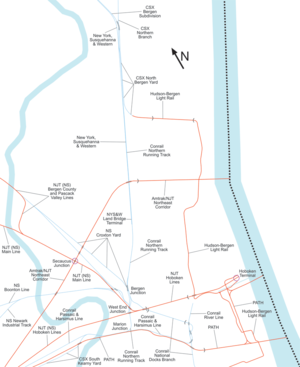Marion Junction (New Jersey)
40°44′16″N 74°04′25″W / 40.737665°N 74.07372°W
Bergen Hill Cut
and Exchange Place
Marion Junction is a
Marion Running Track
.
History
The
New Jersey Palisades; prior to that, passengers and freight transferred to horse-drawn carriages over the hill. The junction was a simple one, with both lines merging towards the east, allowing both railroads to access the east side of the Palisades and the Hudson River.[1]
In 1861, due to congestion on the PRR cut, the Erie built the
trackage rights over the Erie route to Marion Junction in order to reach the PRR cut. NY&GL rerouted passenger trains to the Erie's Pavonia Terminal
about 1890, and NYS&W did the same in 1911. NYS&W continued to maintain a freight house at Marion Junction.
With the decline of the passenger railroads in the mid-20th century, Marion Junction lost much traffic. Facing east, it was not in the best alignment for freight traffic between upstate New York and points south.
Around 1994,Hudson-Bergen Light Rail. This made the junction the preferred (and in some cases the only) route for freight traffic.[3]
See also
- Hudson Connecting Railway
- Croxton, Jersey City
- Long Dock Tunnel
- List of New Jersey railroad junctions
References
- ISBN 9780801872228.
- ^ Convissor, Daniel (April 4, 1999). "Marion & West End Junctions". Retrieved September 8, 2008.
- ^ Berliner, Harvey L and Campo, David W., (Parsons Brinckerhoff Quade & Douglas, Inc.), Dickerson, Charles N. and Mack, Glenn, New Jersey Transit. "Design and Construction of the Weehawken Tunnel and Bergenline Avenue Station for the Hudson–Bergen Light Rail Transit System" (PDF). Civil Design. Retrieved January 20, 2012.
{{cite web}}: CS1 maint: multiple names: authors list (link)
